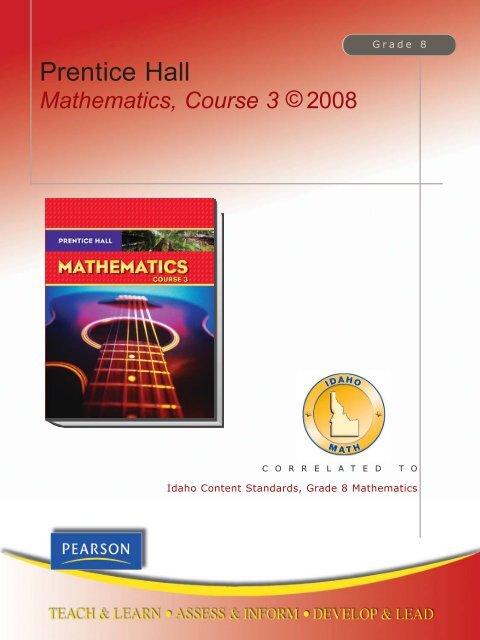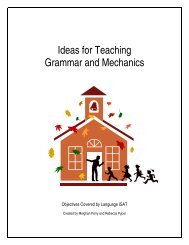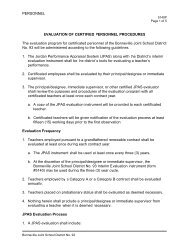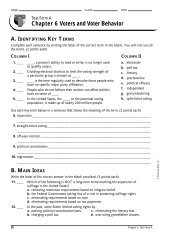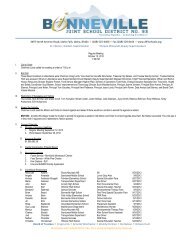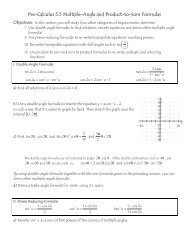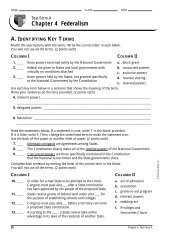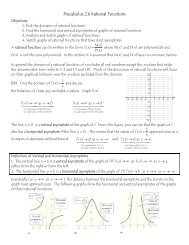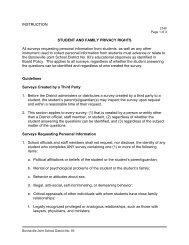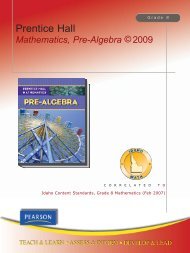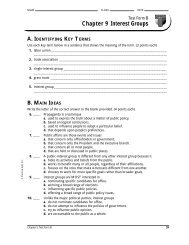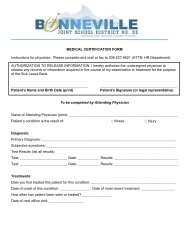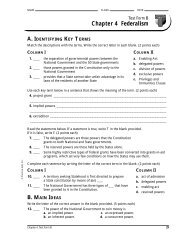Prentice Hall Mathematics, Course 3
Prentice Hall Mathematics, Course 3
Prentice Hall Mathematics, Course 3
You also want an ePaper? Increase the reach of your titles
YUMPU automatically turns print PDFs into web optimized ePapers that Google loves.
<strong>Prentice</strong> <strong>Hall</strong><strong>Mathematics</strong>, <strong>Course</strong> 3 © 2008Grade 8C O R R E L A T E D T OIdaho Content Standards, Grade 8 <strong>Mathematics</strong>
<strong>Prentice</strong> <strong>Hall</strong> <strong>Mathematics</strong>, <strong>Course</strong> 3 © 2008Correlated to:Idaho Content Standards, Grade 8 <strong>Mathematics</strong> (Feb 2007)<strong>Prentice</strong> <strong>Hall</strong> <strong>Mathematics</strong>, <strong>Course</strong> 3 Program Organization<strong>Prentice</strong> <strong>Hall</strong> <strong>Mathematics</strong> supports student comprehension of the mathematics by providing wellorganized sequence of the content, structure of the daily lesson, systematic direct instruction, andteacher support provided for each lesson.Content Sequence - <strong>Prentice</strong> <strong>Hall</strong> is organized with the goal of addressing all of the mathematicsstandards through direct and effective instruction, building concept upon concept, skill upon skill in anorder that is pedagogically sound. The Table of Contents shows the smooth flow of the book, withprerequisite skills and concepts presented before the more complex topics that depend on them.Starting the Chapter - Every chapter begins by reviewing the previous standards that have beenlearned and overviewing the standards that will be covered in the chapter. New Vocabulary isidentified to prepare students for the chapter. Finally, Check Your Readiness questions assess studentunderstanding of necessary prerequisite skills and identifies which lesson they can go to for anynecessary remediation.Lesson Organization - The daily lesson is structured and presented in a consistent format thatenables teachers to effectively present the content and monitor student understanding.• The Instant Check System is a system of assessments that helps ensure standards mastery.It is comprised of assessments to use before, during, and after instruction so teachers caneasily and effectively monitor student understanding.o Each lesson begins with Check Skills You’ll Need to ensure students have thenecessary prerequisite skills for success in the lesson. A Go for Help reference directsthem to a previous lesson if remediation is necessary.o Check Skills questions after every single example provide a way to check studentounderstanding during instruction.Finally, Checkpoint Quizzes occur after instruction to continually monitor studentprogress.• Daily Standards Practice is provided with a comprehensive exercise set following everylesson. Each exercise set is leveled to ensure a variety of practice. Test Prep and MixedReview ensures students also have a daily opportunity to practice concepts and skillspreviously mastered.Concluding the Chapter - The following features conclude each chapter, providing opportunities forstudents to review all standards and demonstrate mastery. This part of the systematic instructionprovides regular opportunities for review and practice and ensures focus on and mastery of thestandards.• Chapter Review – The Chapter Review serves as a chapter study guide for students byreviewing the key concepts covered in each lesson and providing an opportunity to practice. Inaddition, key vocabulary is reviewed.• Chapter Test – Students demonstrate their understanding of the entire chapter bycompleting this practice chapter test.• Test Prep Cumulative Practice – This provides a regular opportunity for students topractice and demonstrate mastery of all the standards that have been covered. If remediationis necessary, students are directed to a previous lesson where each concept was taught.SE = Student Edition1TE = Teacher’s Edition
<strong>Prentice</strong> <strong>Hall</strong> <strong>Mathematics</strong>, <strong>Course</strong> 3 © 2008Correlated to:Idaho Content Standards, Grade 8 <strong>Mathematics</strong> (Feb 2007)Assessment<strong>Prentice</strong> <strong>Hall</strong> <strong>Mathematics</strong> provides teachers with the assessment tools needed to inform instructionand document student progress.The Progress Monitoring Assessments contains all the program assessments needed to evaluatestudent understanding, monitor student progress, and inform future instruction. The followingassessments are included:• Formative Assessmentso Screening Test – check student readiness at the beginning of the school yearo Benchmark Tests – monitor student progresso Test-Taking Strategy Practice Masters – provide opportunities to improve problemsolvingskills• Summative Assessments – All the summative assessments are provided in two forms – onleveland basic versions. Both forms fully assess student progress on the course content, butthe basic versions have been modified for special needs students.o Quarter Tests – on-level and basic versionso Mid-<strong>Course</strong> Tests – on-level and basic versionso Final Tests – on-level and basic versionsThe Test Preparation Workbook contains review lessons and multiple-choice practice tests.Technology, such as the ExamView® CD-ROM, allows teachers to create customized assessment,with all test items correlated to state standards.Universal Access<strong>Prentice</strong> <strong>Hall</strong> <strong>Mathematics</strong> provides better solutions for meeting the needs of every student in theclassroom. Universal Access can be fostered by modifying instruction to address individual needs, andprovided adapted resources when appropriate. <strong>Prentice</strong> <strong>Hall</strong> uses a systematic method for labeling andidentifying resources and instructional support. This consistency helps teachers easily identify andchoose the appropriate support for specific populations of students. The Teacher’s Edition providesuniversal access strategies in detailed daily lesson plans, and daily teaching notes to help differentiatethe lesson for all learners, including special needs, below level, advanced and English LanguageLearners. Chapter-level support pages provide teachers with an easy-to-read overview of the chapterresources available and suggest ways in the instructional lesson to use the resources. Key ancillariesto support universal access include the All-in-One Teaching Resources and the All-in-One StudentWorkbooks. The Teaching Resources include leveled practice for every lesson and daily activity labs.The All-in-One Student Workbook, available as both on-level and adapted for special needs, includesdaily notetaking, daily practice, daily guided problem solving, and vocabulary support.Instructional Planning and Support<strong>Prentice</strong> <strong>Hall</strong> <strong>Mathematics</strong> is designed to provide teachers the tools needed to effectively and easilyimplement the program in the classroom.A Road Map for Planning the Year - A Leveled Pacing Chart is provided in the Teacher’s Editionthat lays out a plan for teaching all the mathematics content standards. It suggests time to spend oneach Chapter, and offers support for adjusting the instruction to meeting the pacing needs of allstudents.Planning a Chapter - The Teacher’s Edition begins each chapter with a series of planning pages.These pages provide an overview of the chapter and make it easy to determine how to individualizelessons for specific students.SE = Student Edition2TE = Teacher’s Edition
o<strong>Prentice</strong> <strong>Hall</strong> <strong>Mathematics</strong>, <strong>Course</strong> 3 © 2008Correlated to:Idaho Content Standards, Grade 8 <strong>Mathematics</strong> (Feb 2007)Planning Daily Instruction - Teachers can use a variety of program materials to organize theirteaching. The primary planning tools are the Teacher’s Edition and the Teacher Center Planning CD-ROM. The Teacher’s Edition includes step-by-step, daily support for directing instruction. Support isorganized systematically around a 4-step teaching plan of Plan, Teach, Practice, and Assess/Reteach.Instructional Tools to Plan, Teach, and Assess:• Core Componentso Student Edition – Thorough coverage of the standards, with built-in assessments andongoing student supporto Teacher’s Edition – Provides comprehensive support for planning, teaching, andproviding Universal Access• Teacher Supporto All-in-One Teaching Resources - All teaching resources are in one convenientplace. Includes leveled practice, chapter projects, alternative assessments, cumulativereviews, guided problem solving masters, and vocabulary support.o Progress Monitoring Assessments – Provides support for formative and summativeassessment, with comprehensive resources for monitoring progress on the standards.o Test Preparation Workbook – Provides instruction and practice on specific testtaking strategies.o TeacherEXPRESS CD-ROM – Powerful lesson planning software, Teacher’s Edition,and Teaching Resources.o PresentationEXPRESS CD-ROM – Complete support for digital presentations oflessons including videos, activities, stepped-out examples, quick check assessments,online active math, and Mindpoint Quiz Show to review chapters.o ExamView Test Generator CD-ROM – Allows teachers to quickly and easilygenerate tests correlated to the standards.• Student Supporto All-in-One Student Workbook –• Structured daily notetaking pages for every lesson• Practice for every lesson• Guided problem solving pages for every lesson with scaffolded questions• Vocabulary and study skills focusing on key mathematical vocabularyo All-in-One Student Workbook, Adapted Version – Adapted for special needsstudents. Includes all the resources in the regular All-in-One Student Workbooks, in anadapted form.o Student Text Online – Complete interactive textbook with videos built-in at point-ofuse,digital activities, stepped-out examples, vocabulary support – and more. Alsoincludes the All-in-One Student Workbooks.o StudentEXPRESS CD-Rom – Interactive Textbook, Homework Video Tutors, ActiveMath Interactivities and Student Worksheetso Companion Websites - Grants instant access to a wealth of resources to supportlearning including vocabulary quizzes, lesson quizzes, data updates, tutorials, chaptertests, and homework video tutors.• Transparency Packageo Classroom Aid Transparencies - Full-color multi-use transparencies such as graphs,fraction strips, and manipulativeso Additional Examples on Transparencieso Daily Skills Check and Lesson Quiz Transparencieso Standards Review TransparenciesStudent Edition Answers on TransparenciesSE = Student Edition3TE = Teacher’s Edition
<strong>Prentice</strong> <strong>Hall</strong> <strong>Mathematics</strong>, <strong>Course</strong> 3 © 2008Correlated to:Idaho Content Standards, Grade 8 <strong>Mathematics</strong> (Feb 2007)IDAHO CONTENT STANDARDS,GRADE 8 MATHEMATICSObjective 7: 8.M.2.1.7 Use appropriatevocabulary and notations. (339.01.f)Goal 2.2: Apply the concepts of rates, ratios, and proportions.Objective 1: 8.M.2.2.1 Use rates, proportions,ratios, and map scales in problem-solvingsituations. (339.03.a)Objective 2: 8.M.2.2.2 Determine unit rates inreal-world situations.Goal 2.3: Apply dimensional analysis.Objective 1: 8.M.2.3.1 Illustrate theinterrelationship of measurement units throughdimensional analysis conversions. (339.04.a)PAGE(S) WHERE TAUGHT(If submission is not a book, citeappropriate location(s))SE/TE: 81, 83, 166, 167, 169, 328, 331, 336,338, 368, 369, 371, 380, 382SE/TE: 162-163, 164, 177-178, 179-180, 183-184, 193-194, 195, 198-200, 202SE/TE: 161-163, 164, 179, 202; RelatedContent: 166-168, 174-176SE/TE: 181-184, 185, 186, 187-190, 191, 194,195, 196, 197-200, 201, 203Standard 3: Concepts and Language of Algebra and FunctionsGoal 3.1: Use algebraic symbolism as a tool to represent mathematical relationships.Objective 1: 8.M.3.1.1 Use variables inexpressions, equations, and inequalities.(340.01.a)Objective 2: 8.M.3.1.2 Translate simple wordstatements and story problems into algebraicexpressions and equations. (340.01.b)Objective 3: 8.M.3.1.3 Use symbols “,”“=,” “≠,” “≤,” and “≥” to expressrelationships. (340.01.c)Goal 3.2: Evaluate algebraic expressions.Objective 1: 8.M.3.2.1 Use and apply thefollowing properties in evaluating algebraicexpressions: commutative, associative, identity,zero, inverse, distributive, and substitution.(340.02.a)Objective 2: 8.M.3.2.2 Use the order ofoperations in evaluating simple algebraicexpressions (340.02.b)Objective 3: 8.M.3.2.3 Simplify algebraicexpressions. (340.02.c)Goal 3.3: Solve algebraic equations and inequalities.Objective 1: 8.M.3.3.1 Solve one- and two-stepequations and inequalities. (340.03.a)Objective 2: 8.M.3.3.2 Match graphicalrepresentations with simple linear equations.(340.03.b)Goal 3.4: Understand the concept of functions.Objective 1: 8.M.3.4.1 Extend patterns andidentify a rule (function) that generates thepattern using rational numbers. (343.01.a)SE/TE: 4-6, 44, 130-134, 153, 201, 276-278,279, 295, 510, 560, 561, 564SE/TE: xli, 4-7, 35, 40, 226, 240, 263, 278,279, 280, 415, 454, 568, 587SE/TE: 13, 35, 40, 65, 226, 240, 263, 278,279, 287, 280, 415, 454, 568, 587SE/TE: 4-8, 26-30, 258, 267, 272-273, 274,277, 562, 563, 590, 648SE/TE: 4-8, 18, 22, 29, 44, 86-89, 99SE/TE: 4-8, 18, 22, 29, 44, 258, 266-269, 295SE/TE: 33-36, 38-41, 208, 261-264, 282-285,294, 295, 300SE/TE: 134, 151, 538, 543; Related Content:135, 535-536, 542,549, 550SE/TE: 85, 91, 130-133, 149, 195, 287, 302,323, 397, 431, 489, 512-515, 570SE = Student Edition6TE = Teacher’s Edition
<strong>Prentice</strong> <strong>Hall</strong> <strong>Mathematics</strong>, <strong>Course</strong> 3 © 2008Correlated to:Idaho Content Standards, Grade 8 <strong>Mathematics</strong> (Feb 2007)IDAHO CONTENT STANDARDS,GRADE 8 MATHEMATICSObjective 2: 8.M.3.4.2 Use relationships toexplain how a change in one quantity may resultin a change in another, and identify therelationship as a positive, negative, or neither.(343.01.b)Objective 3: 8.M.3.4.3 Use appropriatevocabulary and notations. (343.01.c)PAGE(S) WHERE TAUGHT(If submission is not a book, citeappropriate location(s))SE/TE: 527, 528-531, 532, 553; RelatedContent: 536, 539, 540-543SE/TE: 527, 528, 530, 542, 553, 553Goal 3.5: Represent equations, inequalities and functions in a variety of formats.Objective 1: 8.M.3.5.1 Represent a set of data ina table, as a graph, and as a mathematicalrelationship. (343.02.a)Goal 3.6: Apply functions to a variety of problems.Objective 1: 8.M.3.6.1 Use patterns and linearfunctions to represent and solve problems.(343.03.a)Standard 4: Concepts and Principles of GeometryGoal 4.1: Apply concepts of size, shape, and spatial relationships.Objective 1: 8.M.4.1.1 Describe and classifyrelationships among types of one-, two-, andthree-dimensional geometric figures, using theirdefining properties. (341.01.a)Objective 2: 8.M.4.1.2 Draw and measurevarious angles and shapes using appropriatetools. (341.01.b)Objective 3: 8.M.4.1.3 Apply the fundamentalconcepts, properties, and relationships amongpoints, lines, rays, planes, and angles.(341.01.c)Objective 4: 8.M.4.1.4 Identify and model theeffects of reflections, translations, rotations, andscaling on various shapes. (341.01.g)Objective 5: 8.M.4.1.5 Identify congruence,similarities, and line symmetry of shapes.(341.01.d)Objective 6: 8.M.4.1.6 Explain the concept ofsurface area and volume (capacity). (341.01.f)Objective 7: 8.M.4.1.7 Use appropriatevocabulary and symbols. (341.01.h)Goal 4.2: Apply the geometry of right triangles.No objectives at this grade level.Goal 4.3: Apply graphing in two dimensions.Objective 1: 8.M.4.3.1 Identify and plot pointson a coordinate plan. (341.03.a)SE/TE: 130-134, 153, 533, 534-538, 540-543,553SE/TE: 85, 132-134, 323, 397, 515-516, 517,537-538, 542-543, 544-545, 553, 570SE/TE: 302, 303-306, 307-307-310, 311, 312-316, 318-321, 322, 323, 324-327, 328-332,354-357, 358-361, 362, 363, 364-366, 404SE/TE: 304-306, 308-310, 341-343, 344,345358-361, 362SE/TE: 302, 303-306, 307-310, 311, 341-343,344, 346, 347SE/TE: 136-139, 140, 141-144, 145, 146-149,150, 153, 185, 186, 187-190, 191SE/TE: 142, 143, 181-184, 185, 186, 187-190,312-316, 191, 398-401SE/TE: 368—372, 373, 374-378, 379, 380-384,387, 388-391, 393-396SE/TE: 136, 137, 141, 142, 143, 146, 148,152, 181, 183, 187, 188, 189, 303, 304, 305,307, 312, 314, 368, 371, 374, 377, 380, 382,393, 395, 398, 400, 404SE/TE: 124-127, 153, 410, 510; RelatedContent: 136-139, 141-144, 146-149, 535, 536,537, 553SE = Student Edition7TE = Teacher’s Edition
<strong>Prentice</strong> <strong>Hall</strong> <strong>Mathematics</strong>, <strong>Course</strong> 3 © 2008Correlated to:Idaho Content Standards, Grade 8 <strong>Mathematics</strong> (Feb 2007)IDAHO CONTENT STANDARDS,GRADE 8 MATHEMATICSStandard 5: Data Analysis, Probability, and StatisticsGoal 5.1: Understand data analysis.Objective 1: 8.M.5.1.1 Analyze and interprettables, charts, and graphs, including frequencytables, scatter plots, broken line graphs, lineplots, bar graphs, histograms, circle graphs, andstem-and-leaf plots. (342.01.a)Objective 2: 8.M.5.1.2 Explain and justifyconclusions drawn from tables, charts, andgraphs. (342.01.b)Objective 3: 8.M.5.1.3 Use appropriatevocabulary and notations. (342.01.c)PAGE(S) WHERE TAUGHT(If submission is not a book, citeappropriate location(s))SE/TE: 223, 245, 323, 412-416, 417, 418-422,423, 424-426, 427, 428-431, 432, 433-437,438-441, 443-447, 450-453, 454-455, 463SE/TE: 223, 245, 323, 415-416, 417, 428-431,432, 436, 447,SE/TE: 412, 413, 414, 418, 419, 420, 424,425, 433, 435, 438, 440, 444, 445, 446, 450,451, 452, 462Goal 5.2: Collect, organize, and display data.Objective 1: 8.M.5.2.1 Collect, organize, and SE/TE: 418-422, 423, 425-426, 433-437, 439-display data with appropriate notation in tables, 441, 442, 443, 451-453, 460, 480-483charts, and graphs, including scatter plots,broken line graphs, line plots, bar graphs,histograms, and stem-and-leaf plots. (342.02.a)Goal 5.3: Apply simple statistical measurements.Objective 1: 8.M.5.3.1 Choose and calculate theappropriate measure of central tendency –mean, median, and mode. (342.03.a)Objective 2: 8.M.5.3.2 Explain the significanceof distribution of data, including range,frequency, gaps, and clusters. (342.03.b)Goal 5.4: Understand basic concepts of probability.Objective 1: 8.M.5.4.1 Model situations ofprobability using simulations. (342.04.a)Objective 2: 8.M.5.4.2 Recognize equally likelyoutcomes. (342.01.c)Objective 3: 8.M.5.4.3 Explain that probabilityranges from 0% to 100% and identify a situationas having high or low probability.Objective 4: 8.M.5.4.4 Use the language ofprobability. (342.04.b)Goal 5.5: Make predictions or decisions based on data.Objective 1: 8.M.5.5.1 Make predictions basedon experimental and theoretical probabilities.(342.05.a)Objective 2: 8.M.5.5.2 Conduct statisticalexperiments and interpret results using tables,charts, or graphs. (342.05.c)Objective 3: 8.M.5.5.3 Use appropriatevocabulary and notations. (342.05.b)SE/TE: 412-416, 417, 418, 419, 420, 421, 434,435, 436, 437, 462SE/TE: 413, 414, 415, 417, 418-422, 462SE/TE: 248, 470-472, 474, 480-483, 484, 485,488-489, 490, 494-495, 498-499, 505SE/TE: 247; Related Content: 246, 248-260,253, 470-472, 474, 475-476SE/TE: 247-250, 470-473, 474, 475-478, 484,486-489, 504, 505SE/TE: 246, 247, 248, 252, 470, 471, 472,479, 486, 487, 488, 491, 493, 496, 498, 500SE/TE: 475-479, 505; Related Content: 246-250, 253, 474SE/TE: 246-250, 418-423, 438-442, 444-447,462, 463, 470-473, 480-483, 484, 486-489,491-495, 496-499, 505SE/TE: 246, 247, 248, 418, 419, 420, 438,440, 444, 445, 446, 470, 471, 472, 480, 481,482, 486, 487, 488, 491, 493, 496, 498, 500,504SE = Student Edition8TE = Teacher’s Edition
<strong>Prentice</strong> <strong>Hall</strong> <strong>Mathematics</strong>, <strong>Course</strong> 3 © 2008Correlated to:Idaho Content Standards, Grade 8 <strong>Mathematics</strong> (Feb 2007)Standards link: http://www.sde.idaho.gov/ContentStandards/docs/MathStandards/ICSGrade8math.docSE = Student Edition9TE = Teacher’s Edition


